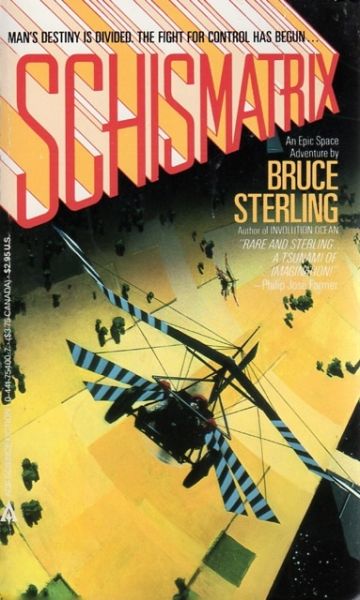You Say You Got A Real Solution
Schismatrix
By Bruce Sterling

27 Apr, 2019
Bruce Sterling’s 1985 hard SF novel Schismatrix is the sole novel set in his Shaper/Mechanist universe, a setting also featured in handful of short pieces1.
The human colonies of the Solar System are divided into two factions: the Shapers, who want to enlist biology in reshaping humanity, and the Mechanists, who rely on technology. The two sides loath each other and are engaged in an increasingly tense cold war. It isn’t clear which camp will shape humanity’s future.
Abelard Lyndsay, born to a high-ranked family in the Mare Serenitatis Circumlunar Corporate Republic, was sent as envoy to the Shaper city-states in the Rings of Saturn. This was during a brief period when the Republic was flirting with a Shaper alliance. Once the lunar aristocrats allied with the Mechanists, Abelard found himself an embarrassing relic of a failed policy.
Already radicalized by the Shapers, Abelard turned to extreme political gestures. Upshot: Abelard’s lover Vera dead, and Abelard an exile from his former home.
Abelard uses his political savvy and glib patter to con folks into financing his projects. All is going well until … some unsettling news arrives from his former home.
There was a third member of his faction: Constantine. With Vera dead and Abelard gone, Constantine has leveraged public disquiet into a successful power grab. The new ruler regards Abelard as a potential rival and has dispatched a ruthless killer to assassinate his former friend.
Abelard jumps on the first outbound ship, which just happens to be a small mercenary ship crewed by the whole of the Fortuna’s Miner’s Democracy. The Democracy is on its way to an isolated Shaper post in the Belt to do their part for the war effort. The half-dozen or so citizens of the Democracy are plucky, but little burdened by basic competency. The whole adventure goes… badly. Lindsay survives and so does Nora, the Shaper woman with whom Lindsay has fallen in love.
Having achieved close to mutual Total Party Kills, the survivors of the two factions (Shapers and Mechanists) learn that peace has suddenly been declared. The long-awaited first contact with aliens has finally happened. In the face of extrasolar contact with a superior civilization, humanity must present a unified front and that means the whole Shaper/Mechanist dispute needs to be backburnered for the moment.
Life is about to become much more complex.
~oOo~
This book is a character study: Abelard, once a young hothead, becomes a competent diplomat. It is also a tour of Sterling’s post-human solar system. The novel is a brief 288 pages in paperback; the plot covers the years 2215 – 2386. The plot moves briskly2 and changes direction frequently. As a consequence, none of the settings are described in much detail.
Nor are there women characters of much interest or agency. Whenever Abelard does hook up with someone, that someone is soon moved offstage or dead. Sometimes both.
Still, Sterling has put some thought into his future. This is not a utopia of bright and shiny wonders. The polities of the Solar System are subject to entropy and decay. Nothing lasts, marvels are soon tarnished, and the causes for which one was eager to die may appear rather absurd a few years down the road.
Schismatrix deploys an full assortment of the standard tropes of the period: space cities, transformative technology, a worn-out Earth cut off from the mainstream of society, a universe not particularly inclined to facilitate a comfortable future. Other authors (Varley, Sargent, Swanwick, Williams, and their imitators) were playing with the same tropes, but few quite so nicely.
If you’re unfamiliar with space-based cyberpunk-affiliated SF of the mid-1980s, this might not be a bad place to start.
Schismatrix is available as part of Schismatrix Plus here (Amazon), here (Amazon.ca) and here (Chapters-Indigo).
1: The short pieces and the novel were collected in 1996’s Schismatrix Plus but since this is a review series focused specifically on the 1980s, I will tackle the novel as it appeared in the Reagan Era.
You may ask how I reconcile this with having reviewed all of Akira last week despite a fair chunk of the translation being the product of the 1990s. Look, the Winged Victory of Samothrace!
2: This was Sterling’s first novel written on a word processor. Access to modern technology did not inspire him to produce a bloated tome. As it did too many of his colleagues.
